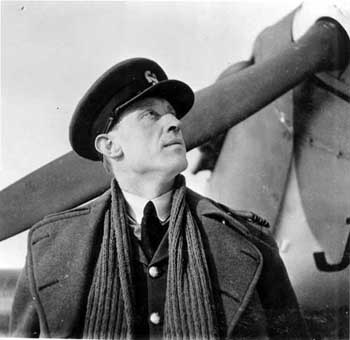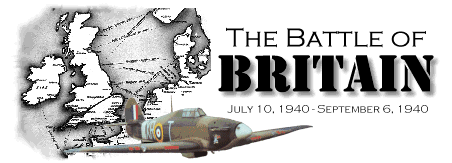
In fact, plans for a German invasion, named Operation Sea Lion, were in the
works. The key to this plan was the establishment of German air superiority over
southern England and the English Channel. That task fell to Goering and his
Luftwaffe. What ensued would be the world's first strategic bombing campaign and
the world's first battle entirely decided in the air, the Battle of Britain.
While the Luftwaffe had in excess of 2,000 combat ready aircraft (as opposed
to the 675 in British inventory) from France to Norway that could strike
England, this would be the first time they would be used in a non support
manner. In other words, up to this point the German Air Forces had played a
support role to the German Ground forces. German planes were designed for short
distance tactical strikes and local air superiority. They lacked strategic heavy
bombers. More importantly, they lacked quality fighters with the fuel endurance
to act as escorts to the bombers they did have (NOTE: the yellow area in the
maps is the area that could be reached by German fighters).
PLANES: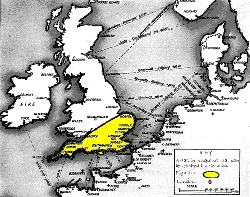 BACKGROUND:
BACKGROUND:
After the
unexpected and unthinkably rapid falls, first of Poland, then France, Britain stood alone against the
apparently unstoppable German war machine. Invasion seemed imminent.
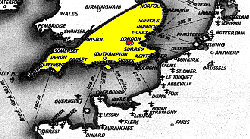 In regards to the British, they were out numbered and were
facing a much more experienced, better equipped fighting force. They did,
however, have a few important factors on their side. First, and most
importantly, Britain had a very well developed Radar system and coordination
method that allowed for early warning and attack of incoming German forces.
Secondly, they were fighting over friendly territory. If a German was shot down,
if he survived, he was captured and lost to his side. In the case of the
British, a downed pilot could be up the next day and in some cases later even
that same day. Third, the British were joined by a group of over 140 excellently trained Polish Air Force veterans of the September 1939 campaign. Initially, on account of their scanty English and because they represented an unknown quantity, the British command was reluctant to use their skills. In time, however, that changed and the Polish pilots contributed significantly to the British victory, downing over 200 of the 1100 planes the Luftwaffe lost during the battle.
In regards to the British, they were out numbered and were
facing a much more experienced, better equipped fighting force. They did,
however, have a few important factors on their side. First, and most
importantly, Britain had a very well developed Radar system and coordination
method that allowed for early warning and attack of incoming German forces.
Secondly, they were fighting over friendly territory. If a German was shot down,
if he survived, he was captured and lost to his side. In the case of the
British, a downed pilot could be up the next day and in some cases later even
that same day. Third, the British were joined by a group of over 140 excellently trained Polish Air Force veterans of the September 1939 campaign. Initially, on account of their scanty English and because they represented an unknown quantity, the British command was reluctant to use their skills. In time, however, that changed and the Polish pilots contributed significantly to the British victory, downing over 200 of the 1100 planes the Luftwaffe lost during the battle.
Germans:
| Bf 109: |
A truly great fighter for that
time period. On paper, it is the best fighter, from either side, to take
part in the battle. It's fatal flaw was its poor fuel load and fuel
economy. It was limited to 20 minutes over English territory before having
to return home. |
| Bf 110: |
This was the only German
fighter with the fuel economy for home - target - home escort. It was not,
however, capable of true fighter performance and it biggest role in the
Battle was the numbers it added to the German "downed"
column. |
| Bombers: |
Since Germany had failed to
develop a long-range, four-engine heavy bomber, the bombing tasks fell
primarily to a pair of twin-engine medium bombers, the Heinkel He 111 and
the Dornier Do 17. The He 111, known as Die Spaten, or "The Spade", could
carry a bomb load of two tons, yet only manage a top speed of 273 miles
per hour. The Do 17, nicknamed "The Flying Pencil" because of its thin
fuselage, was slightly slower at 265 miles per hour, and could carry only
half the bombload of a He 111. Despite their recent successes in the
German conquest of Europe, the He 111 and the Do 17 were out-moded by 1940
standards. The newer, faster medium bomber, the Junkers Ju 88, began
arriving at the airfields in France in mid-1940, but not in large enough
numbers to completely replace the older bombers. The main German dive
bomber in 1940 was the Junkers Ju 87 Sturzkampfflugzeug (dive-attack
aircraft). Otherwise known as the Stuka, the Ju 87 was successful in the
Polish campaign, where its precise bombing ability and the scream from its
landing gear-mounted sirens, called the "trumpets of Jericho", made it a
favorite of the Nazi propaganda machine. But since most of the Polish air
force had been destroyed on the ground, the Stuka had faced little
opposition from fighters that could exploit its slow airspeed. The German
philosophy on Bomber escort, which required the fighters to fly with the
bombers in close formation, crippled the Bf 109, and is probably one of
the biggest reasons the 109 did as poorly as is
did. |
Great Britain:
| Hurricane MkI: |
By far the most important
British aircraft during the Battle. It was constructed of wood and fabric,
covering a strong metal tube framework. As a result, it was less
vulnerable to exploding cannon shells, and could be repaired rapidly on
the ground even when it was severely damaged. It was easily flown and
easily maintained, exactly what the British needed. During the battle it
was generally tasked with attacking the German Bombers, but it did also
establish itself as a dogfighter close enough in attributes to the 109
that pilot skill usually made the difference. Hurricanes accounted for 57%
of downed German aircraft during the Battle. |
| Spitfire MkI: |
First in the long line of
legendary Spitfires, the Mk I was the most modern, most competitive
fighter in the British inventory. The all-metal Spitfire was more agile
than the Hurricane, and was the only British fighter which could confront
the Bf 109 on completely equal terms. Fast and highly maneuverable, it was
based on a radical, oval-wing design that was far ahead of its time.
Normally tasked with fighter suppression, it did a magnificent job and
quickly made a name for itself on both sides of the Channel. However, its
role (43% of downed German aircraft) was seriously hindered by its limited
numbers. |
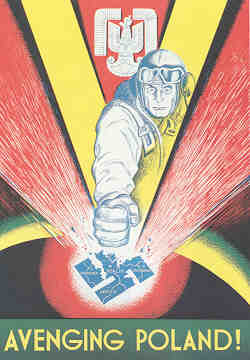 THE BATTLE:
THE BATTLE:
The Opening
Phase: Kanalkampf
The German plan to gain air superiority called for an
all-out attack by the Luftwaffe on the RAF fighter airfields, called Adlertag,
or Eagle Day. The exact date for Adlertag was to be called by Hitler. Until that
date, it was decided that the Luftwaffe would attack British domestic shipping
in the English Channel in the hopes of drawing out the RAF and depleting there
fighter strength.
Beginning July 10, and lasting until early August, the Germans made daily strikes against ship convoys. By the end of this period, the RAF was winning, at least in terms of pure numbers. The Luftwaffe had lost 248 fighters and bombers to the RAF's 148 fighters lost. While these numbers were encouraging to the RAF, it became clear that sustaining such a battle of attrition was impossible. This was not so much because of the loss of fighter craft, as the British fighter production was doing a relatively good job in maintaining fighter numbers. More importantly, the loss in qualified pilots was slowly crippling the RAF. The situation was looking grim, and the real onslaught had yet to materialize.
Aldertag: Eagle Day
On August 1, Fuhrer Directive No.17 was issued
from Hitler's headquarters. It read, in part, "I intend to intensify air and sea
warfare against the English homeland...The Luftwaffe is to overpower the Royal
Air Force...in the shortest possible time...The intensification of the air war
may begin on or after 5 August. The exact time is to be decided by the Air Force
after the completion of preparations and in light of the weather". The Nazi war
machine was again gearing up for battle, Operation Sea Lion.
The plan developed by Luftwaffe command called for a concerted strike against British radar installations (even though most of the Luftwaffe commanders erroneously felt the British Radar Defense System (RDS) was of little consequence). This was to be followed by the actual Aldertag mission the next day against RAF Fighter Command bases. August 10th was set as Eagle Day.
Due to bad weather, the radar strike did not occur until the 12th and this mission was successful. Even though the Germans lost more aircraft than the RAF, they did succeed in downing a significant portion of the RDS. Eagle day itself saw concerted strikes against airfields all over Southern England. These strikes were deemed a great success by the Luftwaffe, who announced they had destroyed 84 fighters and 8 air bases. In truth, it was a failure. The British were able to get all but one of there RDS stations back up which allowed some warning of the oncoming onslaught and allowed them to shot down 46 German aircraft with the loss of only 13 of their own. Also, the bases that were hit belonged to Coastal Command, not Fighter Command. The Eagle had been shot down. The 14th, and 15th saw similar action with 75 German craft downed to only 35 British.
|
At this point, Goering changed the Luftwaffe Strategy. First, he ruled against any further strikes on the RDS deeming them ineffective. Second, it was decided that Stukas would be phased out of the battle, as it had become obvious they were entirely too vulnerable to attack. Third, Bf 110s were moved from there fighter role to a strictly dive bomber role. Additionally, it was decided that they would now have Bf 109 fighter escorts (fighters escorting fighters, an odd use of resources that functionally made the 110s range equal to that of the 109). Lastly, a top priority of destroying RAF fighters was adopted. Toward this end, most 109's were transferred to the German Airbase at Pas de Calais, the closest geographical point to Britain. Also toward that end, smaller bomber groups would be used with heavier fighter escort in the hopes of drawing the RAF into a loaded fight. This would be the strategy that would almost win the Battle of Britain for Germany
This strategy was followed for the next few weeks, and even though the British were shooting down more German planes than they were losing, the Luftwaffe was slowly gaining the advantage. The Germans could afford to loose the planes and pilots, the RAF could not. Fate would then step in in favor of the British. In the very early morning hours of August 25, a lone He 111, who had veared off course, would accidently bomb central London against Hitler's standing orders not to do so. Little did this lost pilot know his actions would alter the course of the battle, and maybe even the war itself.
The British Response
Outraged by such an attack on a completely
civilian target, Churchill order a retaliatory strike on Berlin for that night.
Goering himself had boasted that such a raid would never happen. He had once
stated jokingly that "you can call me Meyer" if it ever occurs. Much to the
amazement of stunned Berliners, on the night of August 25th, 81 British Hampden
bombers appeared over Berlin and delivered a blow to the hart of the Nazi
regime. It was ineffective as a military strike, but people were indeed calling
Goering "Meyer", a deep insult to the anti-Semetic leader. Goering promised it
would never happen again, but additional strike did repeatedly come.
As stated above, these missions were useless in terms of military value, but they hit the Nazi's in probably their most vulnerable spot, Hitler's Ego. He could not allow such an intrusion into the Fatherland go unanswered. He immediately gave a radio address in which he stated "if the British bomb our cities, we will bury theirs", and, against the advise of his generals, issued orders to Goering to institute a merciless bombing campaign against London.
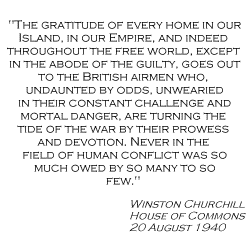 The End of The Battle
The End of The Battle
While the bombing of London
was painful for the British, it did give a much needed break to the RAF forces.
Bases and factories could be repaired, plane inventory could be replaced. With
their increasing strength, the RAF continued to deal the Germans horrendous
losses, finally to the point that the Luftwaffe could no longer afford to absorb
the punishment.
Eventually, all daylight bombing missions were cancelled, and Operation Sea Lion was indefinitely postponed. Night bombing raids would continue (The Blitz), but the Battle of Britain was over, the British had won. Thanks to one lone bomber, a successful "impossible" mission, and Hitler's ego, the last bastion of freedom in Europe had been saved.
Contributed by Rob Wyatt M.D.
Questions, Comments,
Suggestions Email the Author
| Info-Poland a clearinghouse of information about Poland, Polish Universities, Polish Studies, etc. |
